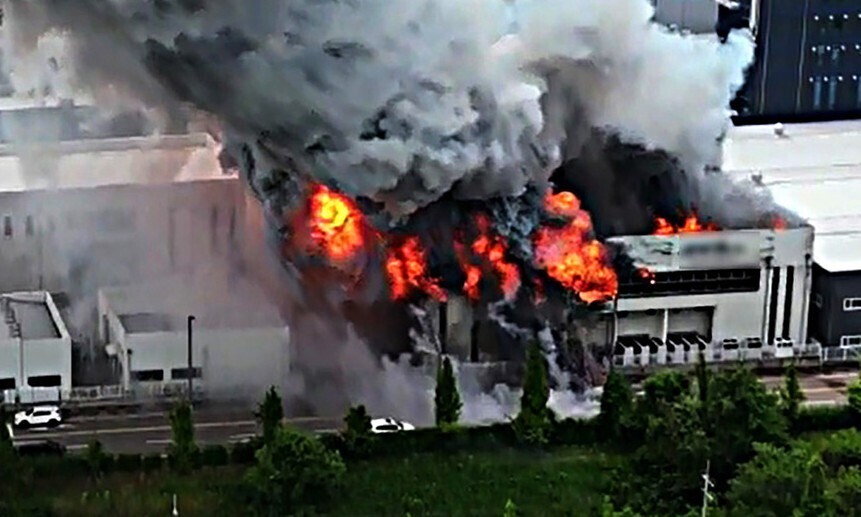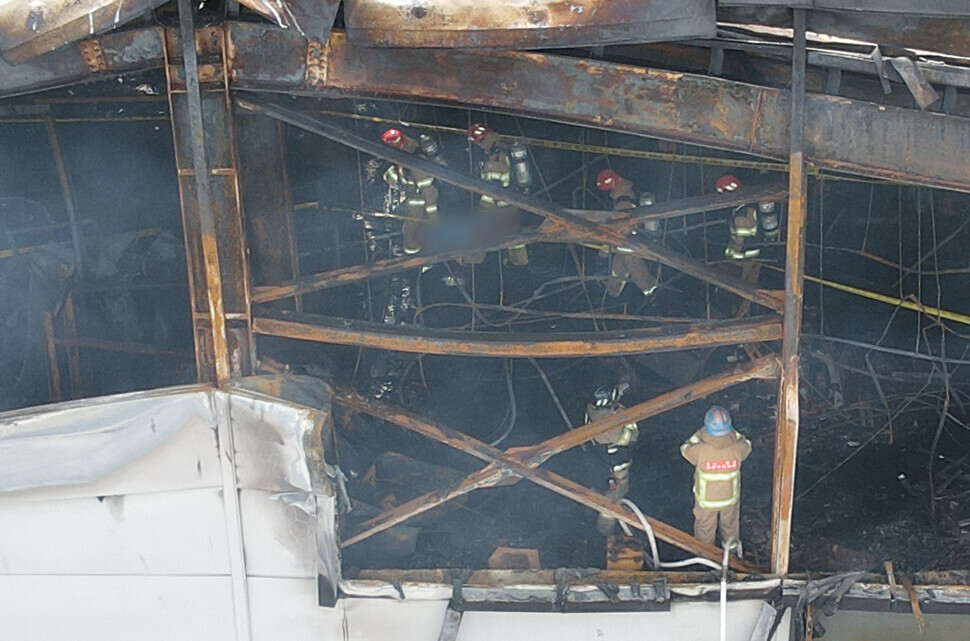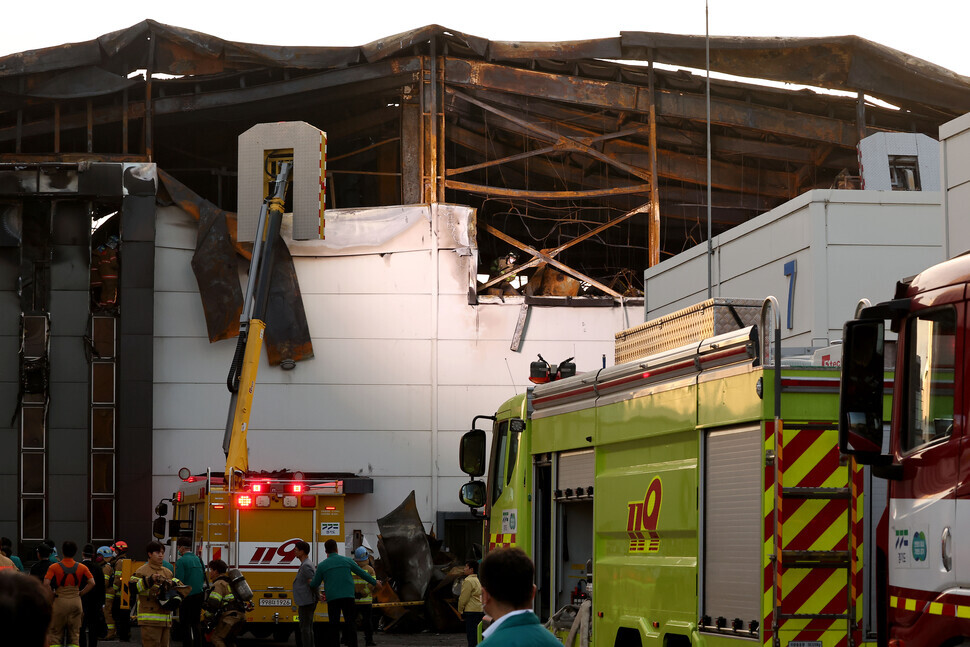hankyoreh
Links to other country sites 다른 나라 사이트 링크
Blaze at lithium battery plant in Korea leaves over 20 dead

Firefighters were powerless in the face of the blaze.
Faced with a new kind of catastrophe when a fire raged at a lithium battery factory, firefighting authorities had no effective means of response beyond preventing the blaze from spreading further and waiting until it had burned itself out before taking action.
In the meantime, over 20 workers lost their lives in the inferno.
The guidelines developed by firefighting authorities for special types of fires involving metal materials left them powerless to rescue the isolated victims before they perished.
On Monday morning, a major disaster occurred when a fire broke out at the lithium battery producer Aricell’s plant in the township of Seosin in Hwaseong, Gyeonggi Province, resulting in 22 deaths and eight injuries.
Because of lithium’s properties as a material, the fire could not be extinguished through the conventional approach of spraying water or carbon dioxide. After failing in their initial attempt to put out the blaze, firefighting authorities were forced to effectively wait for it to burn itself out after putting a fire line in place to prevent it from spreading.

The fire started around 10:31 am in an inspection wing for finished batteries in the plant’s northwest section. While the precise cause remains unknown, firefighters explained that they had “heard from workers at the scene that there was explosive combustion in a battery cell.”
In response to the fire, fire service authorities ordered a Level 2 response, sending 145 firefighters and other fire extinguishing personnel to the scene along with 50 fire trucks and other equipment.
“When the first firefighting personnel arrived, they had difficulty extinguishing the fire because of the rapid spread as battery cells inside the plant exploded one after another,” explained Kim Jin-yeong, head of the Hwaseong Fire Station’s disaster prevention division.
The business in question produced and supplied lithium batteries, with over 35,000 of the cylindrical cells stored in a three-story steel-framed building measuring around 2,300 square meters in total floor area. Firefighters sent to the scene brought dry sand and pressurized nitrogen, which are necessary for extinguishing fires involving lithium.
But the fire proved too large, and after arriving at the plant, the firefighters were left unable to extinguish the flames inside for nearly four hours, focusing instead on preventing them from spreading.
The fire ended up burning out around 3:10 pm — four hours and 40 minutes after it had erupted.
While attempting to extinguish the remaining flames after they abated around 3 pm, firefighters found the remains of 21 people who had burned to death on the building’s second floor. A previous victim had been discovered in cardiac arrest shortly after the fire erupted and subsequently pronounced dead at the hospital.
Firefighting authorities suggested that the victims found inside the plant may have been unable to escape in time due to the swift and explosive spread of a fire that had broken out near the exit.
Most of the victims were foreign nationals, including 18 from China and one from Laos. Two were South Korean nationals.

They were found gathered in a room at the southwest corner of the building’s second floor. “There were two emergency stairwells connecting with the outside of the building, but it looks as though they were unable to escape,” a firefighting official said, pointing to the speed with which the flames spread.
Standard operating procedures established for disasters by the National Fire Agency in 2023 state, “In the case of combustible metals [such as lithium], particles floating in the air present a remaining risk of explosion, and [fires] cannot be extinguished with water, foam, halogen or carbon dioxide extinguishers.”
“Even after extinguishing, a long-term high-temperature state is maintained, which requires caution against the possibility of reignition through means such as contact with liquids,” they continue.
By Lee Jung-ha, Incheon correspondent; Lee Seung-jun, staff reporter
Please direct questions or comments to [english@hani.co.kr]

Editorial・opinion
![[Column] How opposing war became a far-right policy [Column] How opposing war became a far-right policy](https://flexible.img.hani.co.kr/flexible/normal/500/300/imgdb/original/2024/0702/5017199091002075.jpg) [Column] How opposing war became a far-right policy
[Column] How opposing war became a far-right policy![[Editorial] Korea needs to adjust diplomatic course in preparation for a Trump comeback [Editorial] Korea needs to adjust diplomatic course in preparation for a Trump comeback](https://flexible.img.hani.co.kr/flexible/normal/500/300/imgdb/original/2024/0702/9717199086060096.jpg) [Editorial] Korea needs to adjust diplomatic course in preparation for a Trump comeback
[Editorial] Korea needs to adjust diplomatic course in preparation for a Trump comeback- [Editorial] Silence won’t save Yoon
- [Column] The miscalculations that started the Korean War mustn’t be repeated
- [Correspondent’s column] China-Europe relations tested once more by EV war
- [Correspondent’s column] Who really created the new ‘axis of evil’?
- [Editorial] Exploiting foreign domestic workers won’t solve Korea’s birth rate problem
- [Column] Kim and Putin’s new world order
- [Editorial] Workplace hazards can be prevented — why weren’t they this time?
- [Editorial] Seoul failed to use diplomacy with Moscow — now it’s resorting to threats
Most viewed articles
- 110 days of torture: Korean mental patient’s restraints only removed after death
- 2Nine dead in Seoul after car plows into pedestrians
- 3[Editorial] Korea needs to adjust diplomatic course in preparation for a Trump comeback
- 4[Column] How opposing war became a far-right policy
- 5Samsung Electronics workers to go on first strike in company’s 55-year history
- 6Korea to create dedicated population strategy ministry to combat low birth rate, aging society
- 7[Editorial] Silence won’t save Yoon
- 8Japan is building a military meant for more than self-defense — and has the US to thank for it
- 9NewJeans rocks Tokyo Dome as new, younger generation of K-pop fans emerges in Japan
- 10S. Korea joins US, Japan for first multi-domain drills at a time of escalating tensions